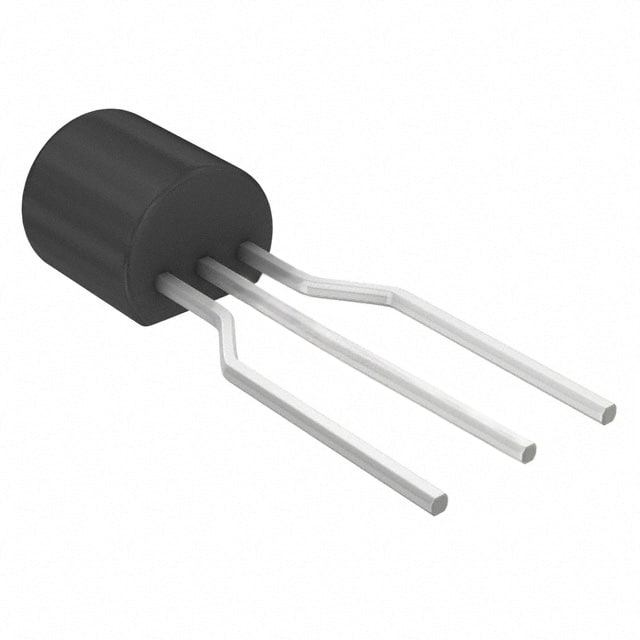2N5087TFR
Product Overview
The 2N5087TFR belongs to the category of bipolar junction transistors (BJTs) and is commonly used for amplification and switching applications. This transistor exhibits characteristics such as high current gain, low noise, and low power consumption. It is typically available in a TO-92 package and is an essential component in various electronic circuits.
Package and Quantity
The 2N5087TFR is commonly packaged in a TO-92 package and is usually available in quantities suitable for both prototyping and production purposes.
Specifications
- Maximum Collector-Emitter Voltage: 50V
- Maximum Collector Current: 50mA
- DC Current Gain (hFE): 100 - 300
- Power Dissipation: 625mW
- Transition Frequency: 100MHz
Detailed Pin Configuration
The 2N5087TFR transistor has three pins: 1. Emitter (E) 2. Base (B) 3. Collector (C)
Functional Features
- High current gain
- Low noise
- Low power consumption
- Suitable for audio amplification and switching applications
Advantages and Disadvantages
Advantages
- High current gain allows for signal amplification without significant distortion.
- Low noise makes it suitable for use in sensitive audio applications.
- Low power consumption contributes to energy-efficient circuit designs.
Disadvantages
- Limited maximum collector current compared to other transistors in its class.
- Moderate transition frequency may limit its application in high-frequency circuits.
Working Principles
The 2N5087TFR operates based on the principles of bipolar junction transistors. When a small current flows into the base terminal, it controls a larger current flow between the collector and emitter terminals. This property enables the transistor to amplify signals and act as a switch in electronic circuits.
Detailed Application Field Plans
The 2N5087TFR is widely used in the following applications: - Audio amplifiers - Signal amplification circuits - Switching circuits - Oscillator circuits
Detailed and Complete Alternative Models
Some alternative models to the 2N5087TFR include: - BC547 - 2N3904 - 2N2222 - BC548
In conclusion, the 2N5087TFR is a versatile BJT with applications in various electronic circuits, particularly those requiring signal amplification and switching capabilities.
[Word Count: 314]
قم بإدراج 10 أسئلة وإجابات شائعة تتعلق بتطبيق 2N5087TFR في الحلول التقنية
What is the 2N5087TFR transistor used for?
- The 2N5087TFR is a general-purpose PNP bipolar junction transistor commonly used in amplification and switching applications.
What are the key specifications of the 2N5087TFR?
- The 2N5087TFR has a maximum collector current of 50mA, a maximum collector-emitter voltage of 50V, and a DC current gain (hFE) ranging from 100 to 300.
How can the 2N5087TFR be used in amplifier circuits?
- The 2N5087TFR can be used as a small-signal amplifier in audio and radio frequency applications due to its moderate power handling capabilities and high current gain.
Can the 2N5087TFR be used in switching applications?
- Yes, the 2N5087TFR can be used in low-power switching applications such as signal routing and control due to its ability to handle moderate currents and voltages.
What are the typical operating conditions for the 2N5087TFR?
- The 2N5087TFR is typically operated within a temperature range of -55°C to 150°C and is suitable for use in various electronic systems and environments.
Are there any common alternative transistors to the 2N5087TFR?
- Yes, some common alternatives to the 2N5087TFR include the 2N3906, BC557, and BC558 transistors, which have similar characteristics and can be used in similar applications.
What are the recommended circuit configurations for the 2N5087TFR?
- The 2N5087TFR can be used in common emitter, common base, and emitter follower configurations depending on the specific requirements of the application.
How should the 2N5087TFR be handled and stored?
- The 2N5087TFR should be handled with care to avoid electrostatic discharge and stored in anti-static packaging or containers to prevent damage to the sensitive semiconductor components.
Can the 2N5087TFR be used in high-frequency applications?
- While the 2N5087TFR can be used in moderate frequency applications, it may not be suitable for very high-frequency designs due to its transition frequency and capacitance characteristics.
Where can I find detailed datasheets and application notes for the 2N5087TFR?
- Detailed datasheets and application notes for the 2N5087TFR can be found on the websites of semiconductor manufacturers, distributors, and industry resources.


